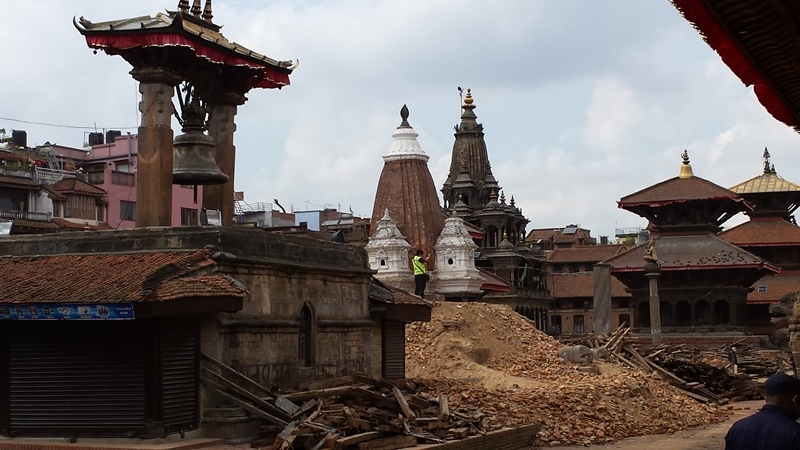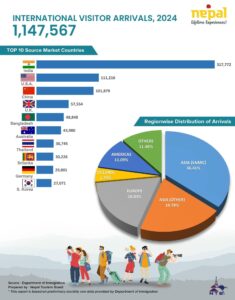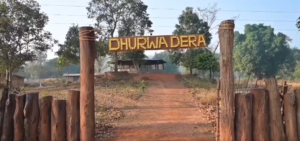‘ Nepal – A Safe Destination ‘ , 581 cultural heritages damaged

By Ramesh Tiwari / TBN —
Kathmandu: Nepal government and travel trade organizations have appealed tourists around the world to visit Nepal and help Nepalese people to overcome their sufferings.
The major earthquake that hit the country on 25 April and May 12 have destroyed most of the heritage sites of Nepal, mainly heritage sites of Kathmandu valley.
A release issued by spokesperson Mohan Krishna Sapkota of the Ministry of Culture, Tourism and Civil Aviation (MoCTCA) states: “The Government used its resources to assess the condition of major tourism products of Nepal including Pokhara, Lumbini, Palpa, Chitwan, Bardiya and Suklalaphanta wildlife safari and beautiful lakes. Nepalese tourism products and destinations are safe and intact. Of all trekking sites and routes of Nepal, Everest Trekking Route (Popularly known as Khumbu Trekking) and Annapuma Trekking Circuit are safe. These routes have least or no impact of quake. “
“Nepal has many places with touristic values and rich cultural traditions. As of now, tourists might have visited Kathmandu and its surroundings. Tourists may be interested to visit other mystical tourism products. There are some must-visit places so that tourists could understand the Himalaya culture and history in depth. It is the high time to explore Nepal and visit virgin destinations of Nepal. We would like to assure that Nepal is safe and secured place to visit,” the statement adds.
Meanwhile, the Ministry of Culture, Tourism and Civil Aviation has prepared Tourism Recovery Action Plan to bring the tourism industry back on track at the earliest. The action plan includes immediate, mid-term and long term reconstruction, relief and package program for the tourism industry
Travel and tourism industry has suffered a lot after devastating earthquake of April 25 and May 12. The earthquake caused loss of Rs 5 billion to the tourism sector.
According to secretary of MoCTCA Suresh Man Shrestha, the action plan has been prepared to rebuild and rehabilitate cultural heritage sites, tourist areas and trekking trails damaged by the earthquake and several aftershocks. The government plans reconstruction of damaged cultural heritages, trekking routes, hotels and homestay facilities.
A consultation meeting on Tourism Recovery held recently by the Ministry of Culture, Tourism and Civil Aviation in coordination with Nepal Tourism Board outlined post quake situation of travel and tourism in the country.The Tourism Recovery Committee (TRC), formed under the chairmanship of Tulasi Prasad Gautam, Director General at the Department of Tourism (DoT) has identified short- and long-term works for speedy recovery of the tourism industry.
581 cultural heritages damaged
A total of 137 important cultural and historical heritage buildings and monuments have been completely damaged and 444 monuments and heritage sites suffered partial damage in the earthquakeas stated by the Department of Archaeology, Nepal.
Most of the UNESCO World Heritage sites and popular tourist attractions, some dating more than 1,700 years , reduced to piles of rubble including Dharahara tower of Kathmandu.
The Ministry of Culture, Tourism and Civil Aviation has come up with an action plan for the protection and reconstruction of heritage sites damaged by the recent devastating April 25 earthquake and its several aftershocks.
Similarly, quake destroyed hundreds of hotels and trails in major trekking routes of the Himalayan country specially in along Manaslu , Langtang and Everest region .
According to UNESCO’s preliminary assessment on the ground, the monuments and sites within the Kathmandu Valley World Heritage property, as well as several other cultural and natural heritage sites located in the area, have been heavily affected. In particular, Durbar Squares of Patan, Hanuman Dhoka (Kathmandu) and Bhaktapur are almost fully destroyed.
Nepal’s natural heritage, in particular the World Heritage site of Sagarmatha National Park, including Mount Everest, has also been severely affected by the earthquake. Minimal impact has been found to the World heritage site of Lumbini, the Birthplace of the Lord Buddha (1997), and Chitwan National Park (1984).
The cultural heritage of the Kathmandu Valley is composed of seven groups of monuments and buildings representing a broad range of historical and artistic achievements for which the Kathmandu Valley is world famous. The seven monuments and sites include the Durbar Squares of Hanuman Dhoka (Kathmandu), Patan and Bhaktapur, the Buddhist stupas of Swayambhu and Bauddhanath and the Hindu temples of Pashupati and Changu Narayan.
Death toll crosses 8,631 in Nepal Earthquake
The death toll in the April 25 devastating earthquake and May 12 powerful aftershock has crossed 8,631 according to the latest updates of the Nepal government.
The death in the April 25 quake is 8,458 and 149 in May 12 aftershock. More than 22,000 are injured in both of the quakes.According to the government reports , 79 foreigners died in the two earthquakes and 112 foreigners are still missing.
A second powerful quake struck on May 12 with its epicenter 76 kilometers east of the capital Kathmandu, as the people were beginning to recover from the devastating earthquake of April 25, 2015. More than 200 aftershocks have been felt since the April 25 earthquake of 7.9 in the Richter scale.
More than 66 thousand Nepal Army personnel, 44 thousand Nepal Police and 22 thousand Armed Police Force personnel are mobilized in the rescue and relief operations in earthquake affected districts of the country.
Similarly, 488,788 private houses have been completely destroyed and 267,282 houses are partially damaged by the earthquake. More than 5,000 school buildings have been totally damaged and 10,000 more schools have suffered partial damage.
The previous deadliest Bihar earthquake of 8.4 magnitude eighty two years ago in 1934 killed at least 8,519 in Nepal and thousands more in neighboring India.
Nepal government announced short-term relief package for earthquake victims primarily focusing on temporary shelter, food items and basic health facilities.Nepal’s Government reports that 32 of Nepal’s 75 districts were affected, mainly in western and central regions, including three cities of Kathmandu valley.
The most affected districts were reported to be Sindhupalchowk , Dolakha, Dhading, Gorkha, Rasuwa, , Kavre, Nuwakot, Ramechhap. Kathmandu, Lalitpur and Bhaktapur .The eastern region was least affected and that the Terai region had been minimally affected.The Nepal Government has requested international assistance in response to the disaster.
May 19, 2015














